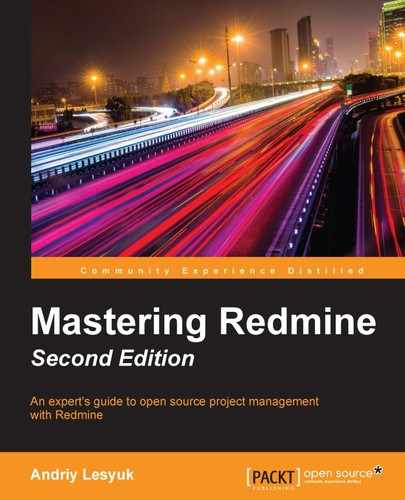Some readers might want to start this book with this chapter, as it looks like an introduction to using Redmine. But it's not an introductory chapter. Usually people first get used to a new place and only then unpack their boxes. And unpacking your boxes and making Redmine your home application is actually what this chapter is about.
Also, this is the first time we will speak about Redmine from the user's perspective. Thus, this chapter will try to answer the following questions:
- What can users do to improve their experience with Redmine?
- How can users get quick access to the needed functionality?
- How can users be sure that they won't miss important updates?
And these are only some of the questions that we will address.
Like the previous chapter, this one is intended for all users. For project managers and site owners, it also gives an idea of what users might need to get a better experience with Redmine.
In this chapter, we will cover the following topics:
- Gravatar
- The personal page
- Getting updates
- Personalizing the issue list
- On-the-fly account creation
Gravatar is a very popular avatar image service (the name stands for Globally Recognized AVATAR). It uses a very simple algorithm to associate an image with a user email. Thus, a client application (Redmine in our case) sends a request with the hash of the user's email to this service and it returns the associated image. If no image is associated with the specified hash, Gravatar returns one of the default images (we reviewed them in The Display tab subsection of The general settings section in Chapter 3, Configuring Redmine).
This simplicity caused Gravatar to be chosen as the source of profile pictures in WordPress and StackOverflow. With custom plugins, support for Gravatars can also be added to Drupal, Joomla, SugarCRM, and so on. This means that, if you configure a Gravatar for Redmine, you will also have it automatically in WordPress, StackOverflow, some Drupal sites, and more.
In practice, however, the majority of Redmine users do not make use of Gravatar. Maybe because Redmine comes with no information anywhere that would explain the possibility for adding a profile picture using this service? So let's review how to do this in this section.
Gravatar uses https://wordpress.com/ user accounts. So, if you are registered on WordPress.com, you can use your existing credentials to sign in to Gravatar. You can do this by using https://gravatar.com/connect link.
If you don't have a WordPress.com account yet, you need to go to https://en.gravatar.com/connect/?source=_signup and register there using the email address that you have chosen or are going to choose for your Redmine account.
After a successful sign-in, you will be redirected to Gravatar's email addresses configuration page, which is shown in the following screenshot:

As you can see, Gravatar allows you to register and manage multiple email addresses under a single account. So, if you have used a different email address in Redmine, you can register it in your existing Gravatar account using this page.
To add a picture, you need to click on either the Add one by clicking here! link or the Add a new image link on this page. Alternatively, you can go to the My Gravatar page and click on the Add a new image link there. After you do this, you'll be given options for uploading images to Gravatar—you will be able to upload them from your computer, specify the URL of the image, use an already uploaded image, or take a picture with a webcam. Finally, after you have uploaded an image, you will be able to select the square area that should be used for the avatar and crop the picture, as shown in the following screenshot:

When you click on the Crop and Finish! button, you will be redirected to the last page of this wizard. On that page, you will be asked to choose a rating for the avatar image, as shown in this screenshot:

Normally, you will need to choose the G rating here (by clicking on the appropriate box). Anyway, you really should not use images with rude gestures, nudity, hard drug use, violence, or sexual content as your avatars in Redmine!
After you have selected a rating, the avatar becomes associated with the email address and is ready to use. So, when you come back to Redmine, you should see the new avatar near the name of the user, as shown in the following screenshot:

Henceforth, this avatar will be shown in almost every place where the link to the user's profile is rendered.
Tip
The Local Avatars plugin
In some cases, you may need to have avatars stored locally, for example, if your corporate network has a limited Internet connection. In such cases, you may use the Local Avatars plugin, which was originally authored by Andrew Chaika. It is available at https://github.com/thorin/redmine_local_avatars.
